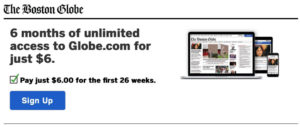By Matt Lindsay, President
01 July, 2020 INMA Blog
Publishers often experience a plateau in their digital subscription volumes. These plateaus occur when digital subscription starts and permanent stops are equal. To breakthrough this equilibrium, without a global pandemic to increase demand, a publisher must adopt strategies and tactics that materially increase starts, decrease stops, or both.
We will discuss a few of the approaches publishers have taken to achieve breakthroughs in subscription volumes, and we share examples where these tactics were used successfully.
CHANGING THE NATURE OF ACQUISITION OFFERS
One of the biggest costs of any subscription business is the cost of subscriber acquisition, and churn from newly acquired customers is one of the biggest obstacles to growth. Innovation in subscription offers that accomplish both goals – increasing starts and decreasing stops – is the holy grail of subscription business models.

Here are a couple of innovations case studies.
Long-term offers
Borrowing a successful tactic from another industry is a time-honored tradition, and in this case study a newspaper adopted an acquisition offer model from the telecommunications industry with great success.
Newspaper subscriptions have typically been sold with short subscription terms, such as three, six, or twelve months. NRC in Amsterdam moved towards long-term offers that were paid monthly. They offer one, two, or three-year terms with guaranteed price points in exchange for a commitment to remain a subscriber through the length of the offer. There are no contracts, but over 92% of new subscribers honor the arrangement.
The result has been growth in subscriptions, including growth in print subscriptions, as the new offers increased the number of “subscription years” sold and dramatically reduced churn.
Extending promotional terms
The point where a customer reaches the end of the promotional offer and moves to the full price is where their churn risk is highest. Extending the length of the promotional offer gives readers sufficient time to make the subscription part of their daily routine, which lowers the probability they will stop they subscription.
The Boston Globe has recently extended their promotional offers to $1 for six months. This dramatic reduction in price per month and the length of the subscription promotion has increased conversion rates and lowered churn for new subscribers. As these customers have reached the end of the six-month offer, they have migrated to full price with less churn that prior new starts.

INCREASING STARTS
Start volumes are a function of the number of sales attempts and the success rate of those attempts. These two variables are inversely correlated, meaning that increasing one usually means reducing the other. Publishers have developed tactics to increase the number of sales attempts to a far greater extent than the corresponding decrease in conversion rates.
Increasing the share of premium content
Publishers have increased sales attempts by lessening the amount of free content available to non-subscribers, either by increasing the percentage of premium content or reducing the number of articles available through a metered paywall. When they increase sales attempts, they are reaching visitors that are not engaged with the content and are less likely to subscribe. Lou Grasser at Le Monde shared that they now have 35% of their content categorized as Premium, which is only available to paying subscribers. There are many subscribers who are motivated to read content that is interesting to them. Content that is premium requires readers to subscribe that may not have under a meter.
Adopting an organizational structure to maximize digital subscription performance
Acquiring digital subscriptions requires organizational capabilities in marketing, technical expertise, analytics, and operations to be integrated and collaborative. Often, these capabilities fall in different functional areas that are difficult to manage cohesively. Reorganizing the staff responsible for these required capabilities so that digital subscription strategies and tactics are under the same management team can dramatically improve performance.
Mark Campbell, CMO of Tribune, centralized that company’s digital subscription operations into one team with control over the strategic direction, customer communication, operational resources, and campaign testing. They leveraged their company’s scale to test new campaigns in one market and quickly roll out successful approaches across the company.
When I asked him about this, Campbell said: “We embraced a centralized approach to digital subscriptions, and my group is focused on measuring the tradeoff between the lifetime value of subscribers with the near-term P&L impact of lost advertising impressions. The pandemic accelerated this process as programmatic CPMs decreased and subscription demand increased, which radically changed the equation. We also now own the levers to execute campaigns. Now execution happens quickly.”
Reducing friction in the checkout process
Many studies have confirmed that reducing the information that must be entered by a reader to make a purchase can increase the conversion rate significantly everything else being equal. The Seattle Times has worked over the years to reduce the amount of data entry required for a digital subscription purchase from over 20 items to three. In addition, they have added additional payment options, such as ApplePay and PayPal, which also increased conversions.
DECREASING STOPS
Churn reduction is a common objective as the industry seeks to retain the new subscribers they acquired during the pandemic. There is also greater appreciation for the return on investment from saving existing subscribers compared with acquiring new subscribers.
Here are a few tactics for reducing stops that focus on addressing the cause of a lost subscription.
Minimize renewal payment friction
The failure of the payment method used for the subscription renewal causes many unintentional stops. There are credit card updating services, software platforms, and payment specialists in this area that can materially reduce this category of stops. We are happy to provide recommendations for service providers in this area.
Proactive targeted retention campaigns
Many stops are due to a lack of engagement or disengagement with the product or poor user experience. Lack of engagement or disengagement with the product can be Identified by observing changes in content consumption patterns.
Poor user experience can be measured by tracking site metrics by visitor. Taking proactive retention steps based on churn indicators that address the cause of a customer’s risk of stopping can reduce subscriber losses. Targeting and testing retention campaigns are very important to earning a positive ROI on this strategy since categorization errors can be expensive.
There are several examples of successful proactive retention campaigns, and we would be happy to share case studies.
On-boarding journeys for new subscribers
New customers need to develop the habit of consuming the content to become engaged readers. Welcoming new subscribers and helping them establish the content habit has helped many publishers with retention.
Several publishers ask new subscribers to opt-in to newsletters on the welcome page, and Gannett has developed an extensive onboarding journey for new customers.
Employ a customer segment pricing strategy
Stops due to an increase in price that exceeded the customer’s willingness or ability to pay are common at certain points in a customer’s subscription lifecycle. Econometric modeling can be used to measure price elasticity, and A/B testing can validate the predicted response to price increases. These insights can support a pricing strategy that recognizes the variability in renewal price elasticity across subscribers and recommends renewal prices that reduce stops, raise ARPU, and optimize reader revenue over time.
Campbell of the Tribune said, “We are always seeking the optimal revenue from each subscriber by balancing the desire to have a Netflix-type flat pricing model with a more dynamic pricing model that better retains price-sensitive customers.”
These business tactics are a few that have helped publishers breakthrough to new levels of digital subscriber volumes and revenue. We hope they help you have a breakthrough as well

